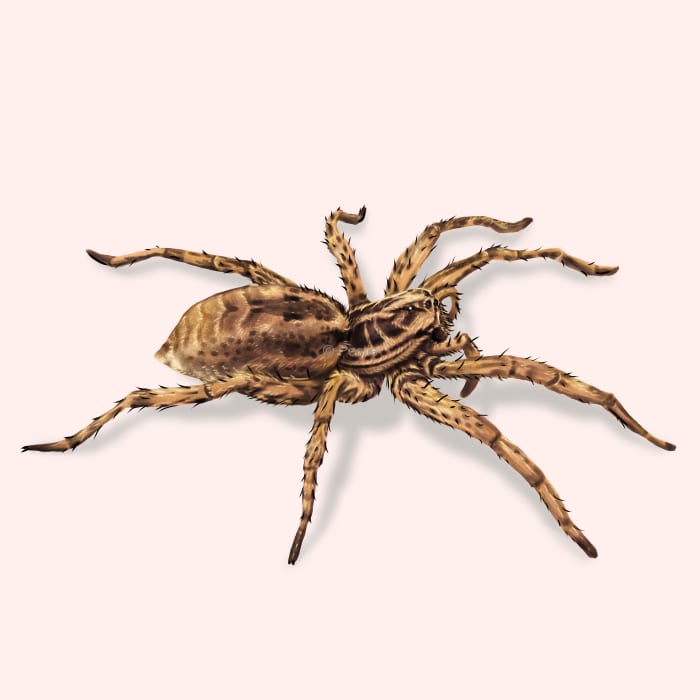How to identify and get rid of wolf spiders

The lone hunters of the spider world
Finding a large spider inside your home can be quite intimidating, especially if you happen to have arachnophobia. Even if you can put on a brave face, not everyone is comfortable knowing a large spider is on the loose in their home.
Wolf spiders may look big and scary, but they aren’t much of a threat. They don’t spin webs to catch their prey, but instead, stalk and hunt their next meals. They go where the insects are. So, if you find them in your house frequently, you might also have some other unseen guests lurking in your halls!
Wolf spiders get their name from their solitary hunting lifestyle. They have excellent eyesight and can move quickly to chase down their prey or will hold still until something moves past them.
Females will carry their egg sacks under their abdomen, and then when they hatch, they climb on her back as she moves around. It can be a little unsettling to see a female wolf spider with a whole bunch of spiderlings hitching a ride on mom!
How to identify a wolf spider
Wolf spiders are often one of the larger spiders you might find in your home. Their color tends to be a mix of brown or gray, with some patterns that can help them blend into their surroundings. Their body also tends to look hairy, like short-haired fur.
But their distinctive eyes – especially those two big ones in the middle – really set them apart from other types of spiders.
How big are wolf spiders?
Some species can grow up to 1.5 inches long, not including their legs.
What other pest looks like a wolf spider?
Because of the fear of spiders, some people automatically think any spider in their home must be a “bad” spider and think they have a brown recluse or tarantula. However, wolf spiders are much smaller than tarantulas and darker in color than brown recluses.
Where do wolf spiders live?
Wolf spiders can be found all across the United States. They live in forests, meadows, and even urban environments. Outside, they are more likely to be found underneath rocks, in leaf litter, or under some sort of cover.
Sometimes, especially when the weather turns cool, they make their way inside. They are often in garages or basements.
How to get rid of wolf spiders
Luckily, wolf spiders aren’t trying to take up permanent residence in your home. One of the best things to do is keep them out of your home in the first place. That includes:
Sealing up cracks and gaps in your home to prevent them from coming inside.
- Reducing outdoor lighting that attracts the insects they feed on.
- Keeping your home clean to discourage the insects wolf spiders prey on.
- Using sticky traps in areas where spiders are frequently seen.
Another great tactic to prevent wolf spiders from coming inside is to establish a long-lasting barrier around your home. Pestie offers a pro-grade DIY plan that is customized to your location. With a perimeter barrier, you can prevent wolf spiders and other pests from invading your home.
Treat wolf spiders with Pestie
If you're still having trouble keeping wolf spiders away, the best option is to use a pro-grade, effective pest control solution like Pestie.
Pestie is a do-it-yourself pest control solution that's specially designed to keep wolf spiders and other pests away from your home.
With Pestie, you can rest easy knowing that your living space is protected and free of creepy crawlies. And the best part? It's designed for people, pets, and the planet, so you can say goodbye to harsh chemicals and hello to peace of mind!
- Save hundreds compared to traditional annual pest plans
- People, pet, and planet-friendly
- Pro-grade customized formulas
Quick facts
- Scientific name
Family - Lycosidae
- Other common names
Ground Spiders, Hunting Spiders, Funnel Web Spiders
- Colors
Brown or gray
- Life span
1-2 years
- Diet
Insects or other invertebrates
How dangerous are Wolf Spiders?
Low danger risk
Wolf spiders are not harmful to humans. They can bite if provoked, but their venom is not dangerous, typically causing no more than minor swelling or itching. Immature wolf spiders are more prone to bite, but their bite is no worse than a bee sting.
You can flash a light across a wolf spider’s eyes, and the light will reflect back. It’s a cool-looking glow that lights up the spider’s eyes. It’s because of a substance in the spider’s eyes called tapetum lucidum. It’s what allows some animals to see in the dark.








